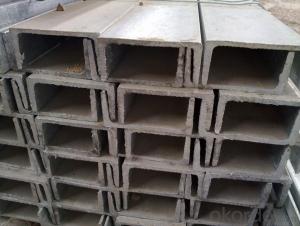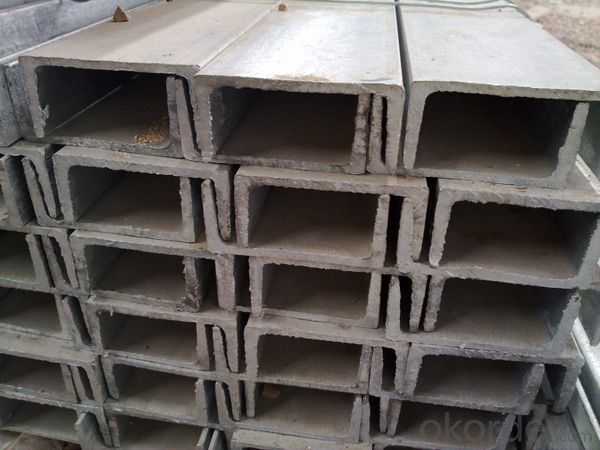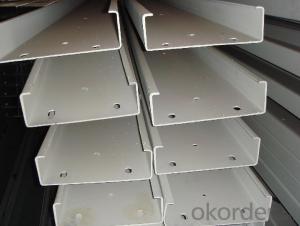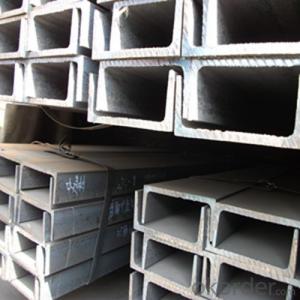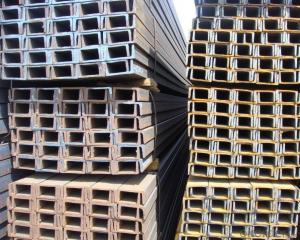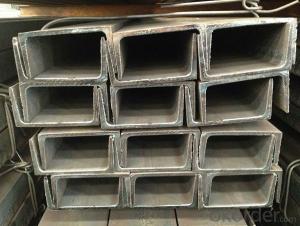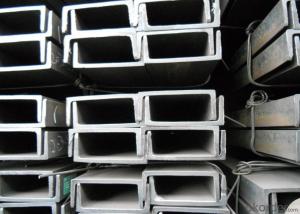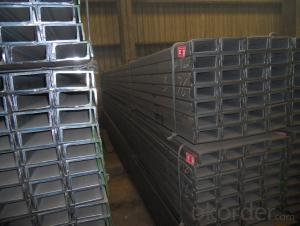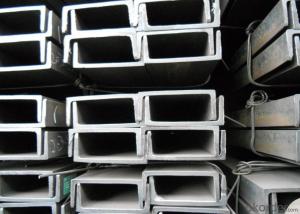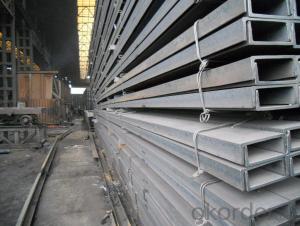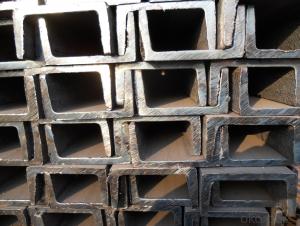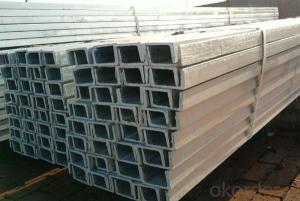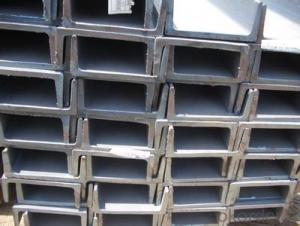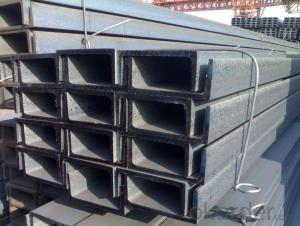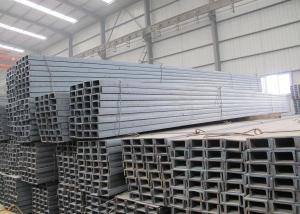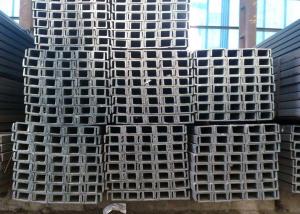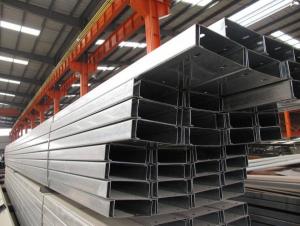UPN Hot Rolled High Quality 80MM-180MM EN Standard
- Loading Port:
- Tianjin
- Payment Terms:
- TT OR LC
- Min Order Qty:
- 25 m.t.
- Supply Capability:
- 20000 m.t./month
OKorder Service Pledge
OKorder Financial Service
You Might Also Like
Product Description:
OKorder is offering UPN Hot Rolled High Quality 80MM-180MM EN Standard at great prices with worldwide shipping. Our supplier is a world-class manufacturer of steel, with our products utilized the world over. OKorder annually supplies products to European, North American and Asian markets. We provide quotations within 24 hours of receiving an inquiry and guarantee competitive prices.
Product Applications:
According to the needs of different structures, UPN Hot Rolled High Quality 80MM-180MM EN Standard can compose to different force support component, and also can be the connections between components. It is widely used in various building structures and engineering structures such as roof beams, bridges, transmission towers, hoisting machinery and transport machinery, ships, industrial furnaces, reaction tower, container frame and warehouse etc
Product Advantages:
OKorder's UPN Hot Rolled High Quality 80MM-180MM EN Standard are durable, strong, and resist corrosion.
Main Product Features:
· Premium quality
· Prompt delivery & seaworthy packing (30 days after receiving deposit)
· Corrosion resistance
· Can be recycled and reused
· Mill test certification
· Professional Service
· Competitive pricing
Product Specifications:
Manufacture: Hot rolled
Grade: Q195 – 235
Certificates: ISO, SGS, BV, CIQ
Length: 6m – 12m, as per customer request
Packaging: Export packing, nude packing, bundled
Sizes: 25mm-250mm | ||||||||||||
a*t | ||||||||||||
25*2.5-4.0 | 70*6.0-9.0 | 130*9.0-15 | ||||||||||
30*2.5-6.6 | 75*6.0-9.0 | 140*10-14 | ||||||||||
36*3.0-5.0 | 80*5.0-10 | 150*10-20 | ||||||||||
38*2.3-6.0 | 90*7.0-10 | 160*10-16 | ||||||||||
40*3.0-5.0 | 100*6.0-12 | 175*12-15 | ||||||||||
45*4.0-6.0 | 110*8.0-10 | 180*12-18 | ||||||||||
50*4.0-6.0 | 120*6.0-15 | 200*14-25 | ||||||||||
60*4.0-8.0 | 125*8.0-14 | 250*25 | ||||||||||
FAQ:
Q1: How do we guarantee the quality of our products?
A1: We have established an advanced quality management system which conducts strict quality tests at every step, from raw materials to the final product. At the same time, we provide extensive follow-up service assurances as required.
Q2: What makes stainless steel stainless?
A2: Stainless steel must contain at least 10.5 % chromium. It is this element that reacts with the oxygen in the air to form a complex chrome-oxide surface layer that is invisible but strong enough to prevent further oxygen from "staining" (rusting) the surface. Higher levels of chromium and the addition of other alloying elements such as nickel and molybdenum enhance this surface layer and improve the corrosion resistance of the stainless material.
Q3: How do you package the angle steel when shipping?
A3: All goods are packed in bundles with steel strips and shipped by container or break bulk.
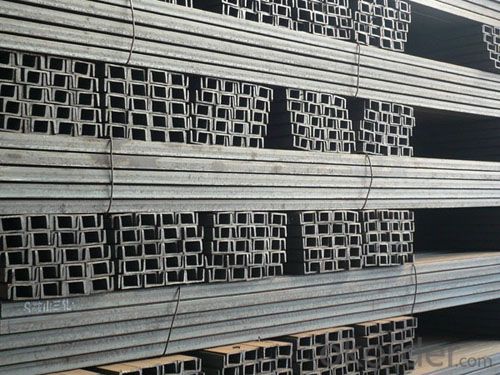
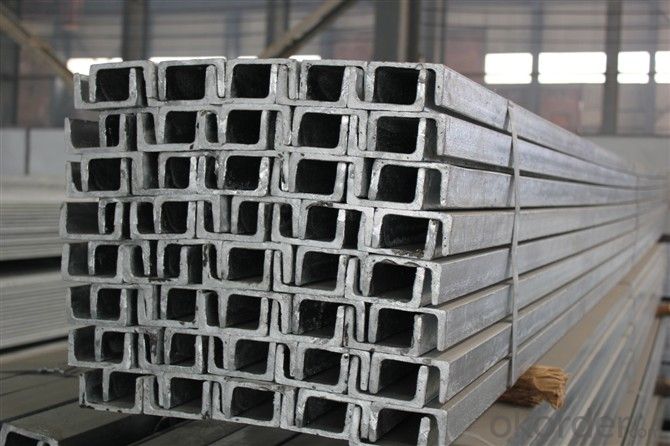
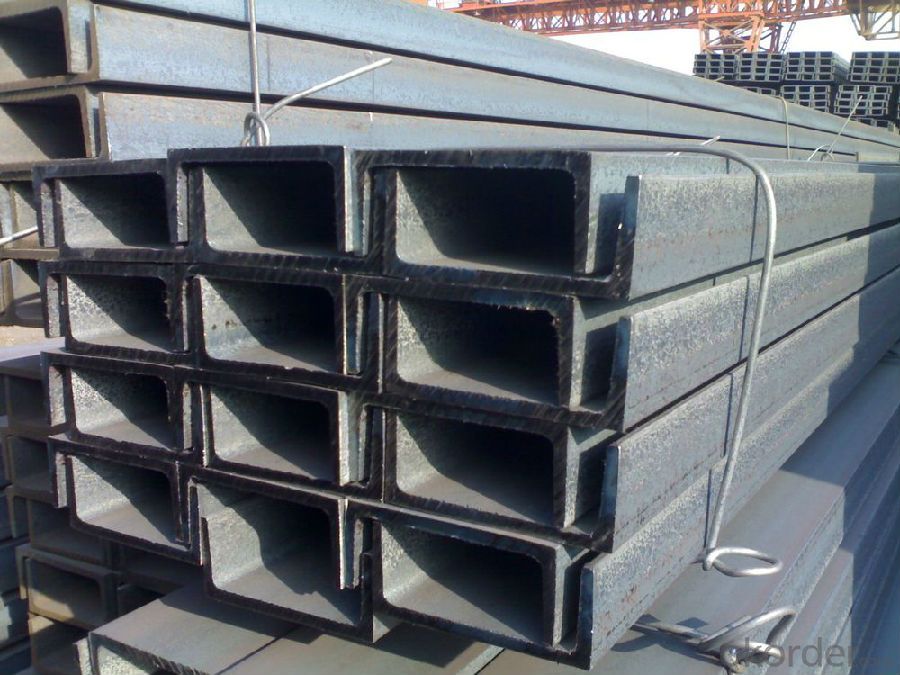
- Q: Can steel channels be used in earthquake-resistant buildings?
- Yes, steel channels can be used in earthquake-resistant buildings. Steel channels are commonly used in the construction industry due to their high strength and durability. In earthquake-resistant buildings, it is important to have a structural system that can withstand the lateral forces generated during an earthquake. Steel channels can effectively distribute and dissipate these forces, making them a suitable choice for earthquake-resistant construction. Steel channels provide several advantages in earthquake-resistant buildings. Firstly, they have excellent load-bearing capacity, which allows them to support heavy loads and resist the forces exerted during an earthquake. Secondly, they have a high modulus of elasticity, meaning they can deform under stress and then return to their original shape once the stress is removed. This flexibility helps prevent brittle failure and allows the structure to absorb and dissipate energy during an earthquake. Additionally, steel channels have a high ductility, which is crucial in seismic design. Ductility refers to the ability of a material to undergo large deformations without breaking. During an earthquake, steel channels can absorb and dissipate energy by undergoing plastic deformation, reducing the overall damage to the structure. Furthermore, steel channels can be easily fabricated and installed, making them a cost-effective option for earthquake-resistant construction. They are also readily available in the market in various sizes and shapes, allowing for flexibility in design. However, it is important to note that the use of steel channels alone is not sufficient to ensure complete earthquake resistance. The overall structural design, including the connections, bracing systems, and foundation, should be carefully considered and designed by a qualified structural engineer to meet the specific seismic requirements of the region. Building codes and regulations also play a crucial role in ensuring the safety and resilience of earthquake-resistant buildings.
- Q: How do steel channels contribute to the overall strength of a structure?
- Steel channels contribute to the overall strength of a structure in several ways. Firstly, they provide structural support and stability by distributing the load evenly across the structure. The shape of steel channels, with a wide base and tapered edges, allows for greater weight-bearing capacity and resistance to bending or buckling under heavy loads. Additionally, steel channels enhance the rigidity of a structure by preventing lateral movement or twisting. They act as beams, creating a framework that resists deformation and ensures the structure maintains its shape and integrity even in challenging conditions, such as during earthquakes or high winds. Moreover, steel channels can be strategically placed in critical areas of a structure, such as load-bearing walls or columns, to reinforce these vulnerable points. By reinforcing these areas, the steel channels increase the overall strength and durability of the structure, reducing the risk of structural failure. Furthermore, steel channels have high tensile strength, which means they can resist stretching or elongation under tension. This property is crucial for structures that experience dynamic loads, such as bridges or high-rise buildings. Steel channels help to distribute and absorb these dynamic forces, preventing excessive deflection or deformation that could compromise the structure's stability. In summary, steel channels contribute to the overall strength of a structure by providing structural support, enhancing rigidity, reinforcing vulnerable points, and offering high tensile strength. Their ability to distribute loads, resist bending or buckling, and withstand dynamic forces makes them a vital component of any robust and durable structure.
- Q: What are the factors to consider when determining the appropriate height of a steel channel?
- When determining the appropriate height of a steel channel, several factors need to be considered. These factors include the load-bearing capacity required, the span or distance between supports, the type and weight of the load being supported, the material properties of the steel channel, and the desired deflection or bending of the channel under load. Firstly, it is crucial to assess the load-bearing capacity required for the steel channel. This involves considering the maximum weight the channel needs to support without buckling or failing. The load-bearing capacity depends on the application and the anticipated loads that will be applied to the channel. The span or distance between supports is another critical factor. Longer spans generally require taller steel channels to provide adequate support and minimize deflection. Shorter spans, on the other hand, may allow for smaller and less rigid channels. The type and weight of the load being supported are also important considerations. Different loads exert different forces on the channel, such as point loads or uniformly distributed loads. Heavier loads will require taller and stronger steel channels to ensure structural integrity. The material properties of the steel channel play a role in determining the appropriate height. Different steel alloys have different strength and stiffness properties. The choice of alloy will depend on the load requirements and the structural design. Lastly, the desired deflection or bending of the channel under load needs to be considered. Deflection refers to the amount of flex or bending that the channel experiences when loaded. In some applications, minimal deflection is desired, while in others, some deflection may be acceptable. In conclusion, when determining the appropriate height of a steel channel, it is vital to consider factors such as load-bearing capacity, span, type and weight of the load, material properties, and desired deflection. A thorough analysis of these factors will help ensure the steel channel is appropriately sized and capable of meeting the intended structural requirements.
- Q: What are the different corrosion protection methods for steel channels in marine environments?
- Steel channels in marine environments face a high risk of corrosion due to the presence of saltwater and harsh elements. To protect against corrosion, there are several methods available: 1. Coating: Applying protective coatings, such as epoxy, polyurethane, and zinc-rich paints, creates a barrier between the steel surface and corrosive elements. This prevents direct contact and subsequent corrosion. 2. Cathodic protection: This method utilizes sacrificial anodes or impressed current to safeguard steel channels. Sacrificial anodes made of zinc or aluminum are attached to the steel channels and corrode preferentially, sacrificing themselves to protect the steel. Impressed current systems use an external power source to provide a protective electrical current. 3. Galvanization: Galvanizing steel channels involves coating them with a layer of zinc, which acts as a sacrificial layer. This sacrificial layer corrodes instead of the steel, providing protection against corrosion in marine environments. 4. Stainless steel: Utilizing stainless steel channels is another effective method. Stainless steel contains chromium, which forms a passive oxide layer on the surface, safeguarding against corrosion. It is highly resistant to corrosion in marine environments and commonly used in critical applications. 5. Proper maintenance: Regular inspection, maintenance, and upkeep are crucial to prevent corrosion in steel channels. This includes removing marine growth, repairing coating damage, and ensuring proper drainage and ventilation to minimize exposure to corrosive elements. It is important to consider factors such as the severity of the marine environment, duration of exposure, and expected lifespan of the steel channels when selecting a corrosion protection method. Consulting corrosion engineers or specialists can assist in determining the most suitable protection method for specific marine applications.
- Q: Can steel channels be used in food processing facilities?
- Yes, steel channels can be used in food processing facilities. Steel channels are commonly used in the construction of industrial facilities due to their durability, strength, and resistance to corrosion. In food processing facilities, where hygiene and cleanliness are crucial, stainless steel channels are often preferred. Stainless steel is resistant to rust and can withstand exposure to water, chemicals, and high temperatures without corroding or contaminating the food products. These channels can be used for various purposes in food processing facilities, including supporting equipment, creating partitions, and forming structural elements. Additionally, stainless steel channels are easy to clean and maintain, making them suitable for use in environments that require strict cleanliness and sanitation standards.
- Q: What are the different types of support brackets for steel channels?
- There are several types of support brackets commonly used for steel channels, including U-shaped brackets, L-shaped brackets, T-shaped brackets, and adjustable brackets. Each type of bracket is designed to provide specific support and stability for steel channels in different applications and load conditions.
- Q: Are steel channels suitable for high-traffic areas?
- Yes, steel channels are suitable for high-traffic areas. Steel is a durable and strong material that can withstand heavy foot traffic and is resistant to wear and tear. Additionally, steel channels provide structural support and stability, making them ideal for areas with frequent and heavy use.
- Q: How do steel channels contribute to the overall acoustics of a building?
- The overall acoustics of a building can be significantly affected by steel channels. These channels are commonly used as structural components in the construction of walls, ceilings, and floors. The manner in which these channels are installed and connected in a building can impact the way sound travels through the space. One way in which steel channels impact the acoustics of a building is by offering a rigid structure that aids in controlling sound transmission. When installed correctly, steel channels can decrease the transfer of sound vibrations between different areas of the building. This is particularly important in spaces where privacy and noise control are crucial, such as offices, conference rooms, or residential units. Furthermore, steel channels can be utilized to establish acoustic isolation between different rooms or floors. By suspending ceilings or creating floating floors using steel channels, vibrations and impact noise can be minimized. This is especially vital in spaces where activities such as music recording, theaters, or classrooms take place, as it assists in preventing unwanted noise from traveling between rooms. Additionally, steel channels can enhance the sound quality within a space by providing a sturdy mounting surface for acoustical treatments such as sound-absorbing panels, diffusers, or bass traps. These treatments can be strategically positioned on the steel channels to enhance the overall clarity and balance of sound within a room, reducing echoes and reverberations. In conclusion, steel channels play a critical role in the overall acoustics of a building by controlling sound transmission, providing acoustic isolation, and allowing for the integration of acoustical treatments. Proper utilization of steel channels during the construction process can help create a comfortable, functional, and acoustically optimized environment for various applications.
- Q: What kind of channel is the best, there is an answer, if not, can come to a formula is OK?
- 6.3# channel steel, Wx=16.1cm^4, Wy=4.5cm^48# channel steel, Wx=25.3cm^4, Wy=7.9cm^4.. These are professional books, professional data, no formula.
- Q: What are the different grades of steel channels?
- The different grades of steel channels include A36, A572, and A588.
Send your message to us
UPN Hot Rolled High Quality 80MM-180MM EN Standard
- Loading Port:
- Tianjin
- Payment Terms:
- TT OR LC
- Min Order Qty:
- 25 m.t.
- Supply Capability:
- 20000 m.t./month
OKorder Service Pledge
OKorder Financial Service
Similar products
Hot products
Hot Searches
Related keywords
